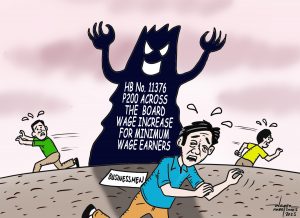NAAWAN, Misamis Oriental (MindaNews)—The Philippine Atmospheric Geophysical and Astronomical Services Administration (PAGASA ) recently announced the termination of the northeast monsoon on Friday, March 22, and the onset of what Filipinos often call summer in the midst of El Niño. Needless to say, summer pushes higher the blazing temperature impacted by El Niño. The sickening heat rages everywhere, except in Baguio and Tagaytay.
The worst to be scorched by summer is expected to be Dagupan City again and neighboring places in Pangasinan. This well-known city received the highest heat index for two consecutive years ( 2021-2022 ) and is at the top of the list of the hottest place in the Philippines. In May 2021, it reached the extreme heat of 53 degrees Celsius, and when the year 2022 approached, it gained a dangerously recorded heat of 54.39 degrees on April 20, 2022, and a scorching 55 degrees on May 2, 2022.
The scorching temperature is currently ravaging agricultural crops in Mindoro, likewise that of the Ilocos region.
Crops and livestock are destroyed by abnormally high temperature; plants are wilted and livestock may die from dehydration. Massive fish kill may also occur in fish farms as dissolved oxygen declines quickly with increasing temperature in the water. High temperature forces out the oxygen out of the water, freeing it back to the air. Even fish in coastal waters may experience fish kill. Now and then, thick aggregates of fish are found gasping in the water near the shoreline chasing after oxygen, vulnerable to predators and humans. This surprising phenomenon often occurs during long dry spell, considered by coastal folk a delightful bonus from heaven.
Humans, on the other hand, suffer most from the spiking heat index. Heat index is a measure indicating the level of discomfort the average person is thought to experience as a result of the combined effects of the temperature and humidity of the air. For example, when the temperature is 32 °C with 70% relative humidity, the heat index is 41 °C. Those affected by increasing heat may experience dizziness, weakness or may succumb to heat stroke.
Worst hit by the double whammy of El Niño and the summer heat are the poor, especially the elderly and very young, who live in small box houses of rusting iron sheet and cardboard in blighted communities which have no access to power and water services. Without electricity to diffuse the stifling air around them and water to cool their bodies, their only option is to find some public parks where trees may offer them temporary refuge, and to bathe amidst floating trash of all kinds in the nearest body of water nearby, no matter how dangerously polluted it may be or how high the level of its E. coli contents. So you will find them, for instance, along Roxas Blvd., and on the shores of Baseco compound in Manila.
(MindaViews is the opinion section of MindaNews. William R. Adan, Ph.D., is retired professor and former chancellor of Mindanao State University at Naawan, Misamis Oriental.)




